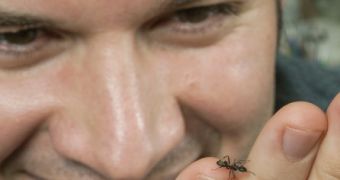It might not be a very common piece of trivia, but ants can lift 5,000 times their own weight, and most of it is borne by the neck. Scientists now want to exploit that in robotics. But first, the team of researchers from The Ohio State University had to really test the limits of ant necks.
So they refrigerated some ants (anesthetic, this was) and then placed them inside a centrifuge.
By spinning the centrifuge, the ants were pressed against the wall. Or would have ended up that way, if their heads weren't glued to the floor.
Long story short, the experiment showed that the necks could take a force of 3,400 – 5,000 times their own weight (though the neck started to stretch at 350x).
Couple that with some scans of the ants made via Micro-CT machines and you have all you need to figure out how to emulate that strength in robots.
Well, presumably. The “graded and gradual transition” of the neck (soft-tissue structure of the neck and the hard exoskeleton of the head and body) might be tricky, and without it, the way the neck is built would lead to the accumulation of stress.
Micro-robots should be feasible though, and maybe someday we'll have larger ones moving around the town.
“Other insects have similar micro-scale structures, and we think that they might play some kind of mechanical role,” said Carlos Castro, assistant professor of mechanical and aerospace engineering at The Ohio State University.
“They might regulate the way that the soft tissue and hard exoskeleton come together, to minimize stress and optimize mechanical function. They might create friction, or brace one moving part against the other.”
Sadly, the strength of the ant is, unfortunately, tied into its size and weight, so there will never be a man-sized robot capable of supporting the mass of a mountain. And even if it were possible, the mountain would probably crumble under its own weight.

 14 DAY TRIAL //
14 DAY TRIAL //